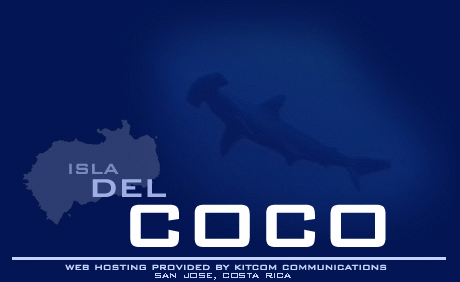 |
|
|
|
|
|
|
|
COCOS ISLAND NATIONAL PARK AND ITS NATURAL HERITAGE by: Fernando Cortes, National Park Service, Costa Rica. copyright: National Parks Foundation, Costa Rica A tiny dark speck on the horizon grows slowly; sea birds appear gradually and hint of the possibility of land nearby; dolphins frolic alongside the boat and guide the way; and the tone of water slowly changes from a deep blue to a tantalizing turquoise. Little by little steep black cliffs, fringed by a dense green vegetation and split by thundering waterfalls, come into view. Transparent water suggests a submarine world hosting coral reefs, sharks, lobsters, manta rays and brilliantly-colored fish. The excitement mounts as your vessel finally arrives at Cocos Island National Park and the discovery begins. Cocos Island, located 600 km. off the Pacific coast of Costa Rica, is one of the most beautiful jewels in the Costa Rican National Park system. It is also one of the most important due to its biogeographic uniqueness and its high number of endemic species, those occurring nowhere else in the world. Of the principal islands of the Eastern Tropical Pacific (Cocos, Clipperton, Malpelo and Galapagos), it is the only one that receives sufficient rainfall to support a tropical rainforest. And since Cocos is a oceanic island, it has relatively few species, some having their origin as far away as the Indian Ocean. The isolated environmental conditions of the island hove favored the evolution of many endemic species and a simplified tropical ecosystem compared with similar ones on the continent, and make Cocos a unique natural laboratory for scientific study particularly in the field of evolutionary biology. PIRATES, WHALERS AND TREASURE Cocos Island was known to mariners and cartographers at least as early as the beginning of the sixteenth century. It was first mentioned as "Y'sle des Cocques'' on a map by Nicholas Desliens in 1541. The island appeared on other maps and in various publications during the following centuries. The abundance of fresh water, wood, pigs (introduced in 1793), fish and
coconuts (also introduced), made this small island a favorite stopping place of
pirates and whaling vessels. The names of various ships carved in the rocks at
Chatham Bay are reminders of these early visitors, some date back as far as the
1600's. NATURAL HISTORY Cocos Island has a circumference of about 23 kilometers (12 km.long by
approximately 5 km. wide) and a land area of 46.6 square kilometers The highest
point, Cerro Iglesias (600 meters above sea level), is located on the western
portion of the island. Since most of the coast is very abrupt and rugged, only
two buys, Chatham and Wafer, both found on the northern end, are safe for
anchorage. The origin of its fauna is mainly eastern Pacific, Galapagos and Central
American mainland, but several groups, including some corals, are of Indo
Pacific origin very few species are related to the Atlantic-Caribbean
province. Fifty-nine species of fish, ninety-seven molluscs, fifty-seven crustaceans, two lizards and seven land birds have been reported. The island has seventy-four species of birds, including three that are endemic: the Cocos Island Flycatcher, (Nesotricus ridgwayi). Cocos Island Finch, (Pinaroloxias inornata) and the Cocos Island Cuckoo (Cocyzus ferrugineus). One of the most startling beautiful of all the birds that visit the island for nesting is the "Espíritu Santo" (White Tern) a small white species which often hovers in the air just a few feet above one's head, totally unafraid of visitors. The flora of Cocos consists of 155 vascular and 48 nonvascular plants, of which about 15% are endemic. Several trails on the Island permit visitors to penetrate the enchanting forests of giant, moss-draped trees, dripping bromeliads, colossall tree ferns, svelte palms and tangled vines. Many unanswered questions about the natural history of Cocos remain for example it is unknown if some of the fish populations live there permanently or migrate into the area periodically. Although current research is continually contributing to our knowledge of the island, basic information of the land and marine biota is needed. Understanding the natural history of the island, park planners and managers will be better equipped to protect the island. STATE OF PRESERVATION Preserving the biological diversity of Cocos Island is the primary objective
of the National Park Service, but this goal is being thwarted for various
reasons. Coffee plants have also modified the island's ecosystem by replacing much of
the under story vegetation of the Genio River, at Wafer Bay. The extent of this
damage and the long-term effects of these introduced species have not been
determined. The inminent threat of destruction to Cocos Island's delicate ecological
balance and the loss of potential scientific research due to the difficulty of
financing boat travel pose serious problems for the future of this unique
area: |
|
[Home] [About us] [The Island] [Links] |